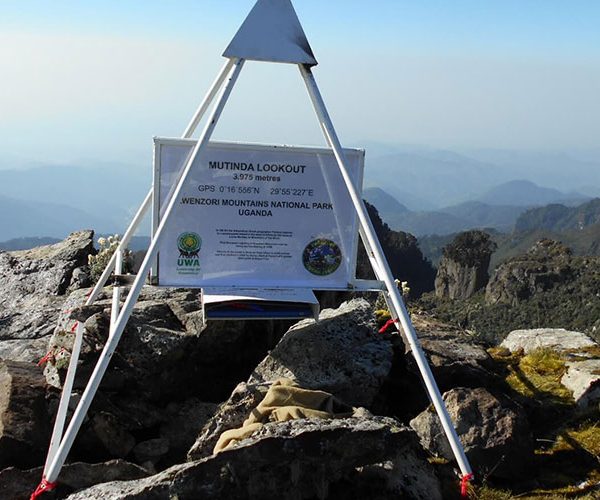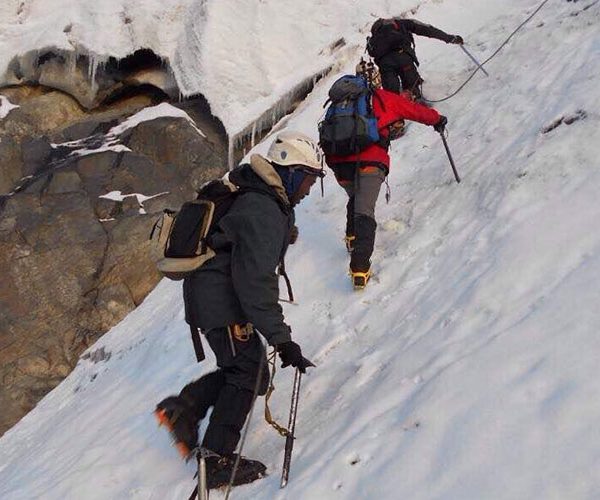05 Day Trek to Weismans Peak
- Home
- 05 Day Trek to Weismans Peak
Day 1: Climb to Sine Hut at 2,596 meters
- Start point: Trekkers at 1,450 meters
- Trek through Afro Montane Forest Zone
- Chance to see various monkeys and bird species
- Enock’s Falls and Sine Camp at 2,596 meters
- Option to proceed to Kalama Camp at 3,134 meters
- Highlights: Beautiful Afro Montane forest, Enock’s Falls, and campfire discussions with guides
Day 2: Climb to Kalalama Camp at 3,147 meters
- Trek through Bamboo-Mimulopsis Zone
- Steep climb with high steps, muddy in wet season
- Reach Kalalama Camp at 3,147 meters in the Heather-Rapanea Zone
- Optional climb to Mutinda Lookout at 3,975 meters for acclimatization
- Highlights: Moss-covered river, Giant Heather trees, and Mutinda Lookout views
Day 3: Climb to Bugata Camp at 4,100 meters
- Trail through boggy areas and Giant Lobelias
- Cross Namusangi Valley with waterfalls and Mutinda Peaks views
- Reach Bugata Camp at 4,062 meters with facilities and helicopter pad
- Highlights: Red Forest Duiker sightings, views of Lake Kopello, and alpine flora
Day 4: Climb Weismann’s Peak 4,620 meters
- Climb Weismann’s Peak and Stella Peak, return to Kiharo Camp
- Total distance: 9km, 4 to 6 hours
- Views of Bugata Lake, Lake Kopello, and Rwenzori Mountains
- Descent to Kiharo Camp at 3,460 meters in the Nyamwamba Valley
- Highlights: Alpine terrain, moss-covered rocks, and panoramic peak views
Day 5: Hike to start point & onwards transfer
- Downhill trek through Nyamwamba Valley
- Stunning views of moss-covered rocks, waterfalls, and forests
- Pass by Riverside Rock Shelter for lunch
- Transfer to the next destination
- Highlights: Beautiful Nyamwamba Valley, diverse flora and fauna, and Riverside Rock Shelter
This trek offers a diverse range of experiences, from lush forests and waterfalls to alpine zones with panoramic mountain views. It combines challenging climbs with opportunities for acclimatization and encounters with unique wildlife, making it a memorable journey through the Rwenzori Mountains.
Day 1: Climb to Sine Hut at 2,596 meters
Pick up from your hotel/ Lodge and transfer to start point. Trekking starts at Trekkers at 1,450 meters and sleep at Sine Hut at 2,596 meters being a height gain of 1,146 meters.
We start by walking up the valley floor through tall forest trees of the Afro Montane Forest Zone. This is a steady climb with multitudes of birds and a chance of seeing blue monkeys scampering off through the forest. At times visitors may see troupes of 15 to 20 black and white Colobus monkeys as they swing through the tree tops. There are rare sightings of the L’Hoest monkey which are part of the Bukonzo cultural emblems and are protected by the virtue of the King or Omusinga or you may hear wild chimpanzee in the distance. There is wide variety of plant species from forest trees to bamboos thickets, low shrubs, flowers, fungi, and with many moss and lichen covered vines hanging from the tall trees creating an awesome appeal. Enock’s Falls are just 200 meters from Sine Hut and offer a splendid opportunity to capture a great screensaver for your memories.
At Sine Camp 2,596 metres we have wooden huts set between tall forest trees on a narrow ridge where you may sit and enjoy the beauty of the Afro Montane forest while you look down at a fantastic waterfall crashing over the rocks far below. Some clients prefer to sit outside enjoying the warmth of the campfire and chat to the guides about the mountains and life in their community. Sine is just below the bamboo zone and the area around has many different bird species. 150 meters from the camp is Enock falls which is set in livid green vegetation and hanging vine. Truly beautiful. Sleep at Sine, or those who are fit and want to proceed to Kalama Camp at 3,134 metres may do so and apart from the fantastic views gives you more time at Mutinda Camp where you may climb up to Mutinda Lookout at 3,975 metres with great views..
Day 2: Climb to Kalalama Camp at 3,147 meters
After a good breakfast, trekking starts at 8.30am and you enter the Bamboo-Mimulopsis Zone which is steep climb with many high steps. In the wet season the bamboo zone is rather muddy and slippery making the going slow. However the atmosphere and the forest is beautiful as you climb 551 metres altitude and a distance of 1.8km to Kalalama Camp at 3,147 meters which is in the Heather-Rapanea Zone where you can take a rest and a quick cup of tea or coffee before heading on to Mutinda Camp. The trail meanders up and over several small knolls along a ridge top then drops down the side of the valley before climbing again, and in doing so cross several small streams and pass close to moss covered waterfalls. You then climb steadily along the side of a beautiful mossy river which tumbles down over the rocks under the Giant Heather trees whose trunks are covered in green moss with old man beards (Usnea lichen) hanging from the branches. The trail twists and turns as you climb up the deep valley, which has an enormous variety of plants and flowers. This valley is unique with many Giant Heather trees creating a beautiful atmosphere often shrouded in mist.
In the afternoon you may wish to climb up to the top of the Mutinda Lookout (one to two hours up and one-hour down) The views are amazing as you stand on moss covered rocks at 3,925 meters with views across the Rwenzori Mountains and down to Kasese town and Lake George. For those clients who are climbing to Margherita or any of the main peaks climbing Mutinda 3,975 meters is also an excellent way to acclimatise and reduce the risk of high altitude sickness.
Day 3: Climb to Bugata Camp at 4,100 meters
The trail here is boggy particularly in the wet season but with a little skill you can step from tussock to tussock to make the going easier. We have put several boardwalks across the worst of the bogs and continuing to build more to make it a little bit easier. You cross the Mutinda valley through the tussock grass and everlasting flowers interspersed with many Giant Lobelias before climbing a steep section up to the Namusangi Valley (3,840 meters), which ends abruptly with sheer waterfalls and fantastic views of Mutinda Peaks. The Namusangi Valley is wide, with many ups and downs and crossing several bogs as the trail climbs steadily to Bugata Camp at 4,062 meters. Bugata Camp is situated way up Bamwanjara Pass high above Bugata Lake with views across Lake Kopello to Weismann’s Peak, which is often covered with snow then down the valley views of Lake Africa and Lake Kanganyika and the many small peaks towards Mutinda Camp. The area is covered with tussock grass, everlasting flowers (Helichrysum), St John’s Wort (Hypericum becquaeritii), giant groundsel (Senecio adnivalis) and Giant lobelia (Lobellia gibberoa). There are a many Red Forest Duiker (Cephalophuc nigrifrons rubidus) which are a sub-species only found in the Rwenzori Mountains.
Bugata Camp has good facilities, solar lights, good toilets and bathrooms where the guides may prepare some warm water in a basin for you to wash. Bugata also has a helicopter pad (GPS reading N 18.312 E29 53.457) in case of any need for rescue by helicopter but be warned that a helicopter in Uganda costs around $10,000 per hour flying time which is way more than other countries so you need insurance in case of rescue.
Day 4: Climb Weismann’s Peak 4,620 metres
Climb Weismann’s Peak 4,620 metres and Stella Peak 4,626 metres 3.7km to Weismanns Peak then another 800 metres to Stella Peak and return. Total distance 9km 4 to 6 hours. The trek starts by walking across the hillside below high cliffs above Bugata Lake then around a ridge point to Lake Kopello where we walk along the edge of the lake which according to researchers the water temperature averages 2˚C As you climbing you get excellent views of the four lakes along the valley below. The last section to the peak is steep on solid rock and can be difficult when snowing or iced up and it may be necessary to use ropes for safety. On a clear day you get awesome views of all the main peaks, Mt Stanley, Mt Speke and Mt Baker. The top of Weismann’s Peak is relativity flat or dome shaped with deep moss growing on the rocks creating a beautiful atmosphere. Stella Peak 4,626 metre is near Weismann’s but needs full technical skills as it is dangerous and needs experience and a good head for heights. We do not advise crossing to Stella Peak.
From the peak we descend directly to Kiharo Camp 3,460 metres down the Nyamwamba Valley. At the head of the valley there is a large area of thick Giant Groundsel with dense evergreen undergrowth and moss with the rocky peaks towering above which creates it’s own micro environment. As you descend the valley you will notice the terrain is made up of several flat boggy areas where millions of years ago glaciers sat and melted leaving a wall of big rocks in front of where it lay. The valley is home to many Red Forest Duiker (Cephalophuc nigrifrons rubidus) At night you may stay in Kiharo Camp at 3,460 metres an area rich in evergreen plants and babbling streams. Particularly during the dryer months the night the air is filled with the calls of the rock hyrax as they sit in the rocky cliffs high above.
Day 5: Hike to start point & onwards transfer
The trail down the Nyamwamba Valley is mostly downhill and absolutely stunning with beautiful views. The moss covered rocks along the river, cascading waterfalls, deep valleys and forests are possibly the best in the Rwenzori Mountains. This part of the trail took six years to find a way through and a route which is easy enough for tourists to use. In 1937 the explorer and geologist McConnell tried to find a way up this valley but failed and had to turn back and search for another route up the mountain but now you can experience this truly beautiful valley.
A few kilometers from Kiharo Camp the path turns off to the right to pass along the river. In the clear areas you may catch a glimpse of a Duiker quietly feeding in small clearings as you pass along the river. If you wish you may prefer to walk down the river itself hopping across the rocks as you pass down. A few kilometres down the river it becomes very steep with multitudes of waterfalls so we have to move away from the river and follow a narrow ridge to bypass steep sections. At the bottom we again meet the river where there is a huge rock shelter called Riverside Rock Shelter where you have lunch. After crossing a small stream you climb up a gentle slope as it is way too steep close to the river. The forest along this section is truly beautiful with many birds, primates, dikers and hyrax. A great experience and ending to a fantastic trek.
Transfer to the next destination
Price includes:
- Ground Transfers
- Park entrance fees
- Mountain Guides
- One porter per client (maximum 15kg luggage)
- Accommodation on Full Board in Lodges and Hotels outside the Mountains
- Accommodation is in our 6 – 8 person permanent tents in the Mountains
- Stretchers & mattresses are provided but you need to bring a warm sleeping bag and clothes.
- All treks include camping and meals however you may desire to bring your personal snacks, sweets or chocolates.
- Evacuation cover to nearest health center / hospital
Price does not include:
- Visas
- International Flight Tickets Or Local scheduled charter flights
- Single room supplements
- Insurance cover
- Breakfast on the first day nor dinner on the last day on trekking
- Additional porters may be hired to carry extra personal luggage (above the 15kg limit) through the company at $15 US per day
- Items for hire, Sleeping bag $10 Warm jacket/sweater $10, Rubber boots free, Gloves $5 Prices are per trek regardless of number of days not per day





